Challenges and Risks in Community Nursing: A Report
VerifiedAdded on 2022/10/09
|11
|2838
|430
Report
AI Summary
This report, prepared for a NURS1102 assignment, delves into the multifaceted challenges encountered by community nurses during home visits. It highlights the core responsibilities of community nurses, including providing preventative care, health management, and patient education within the community setting. The report identifies several key issues, such as stress and burnout, excessive workload, environmental hazards, physical injuries, workplace violence, and difficulties in engaging families in treatment plans. The analysis explores the impacts of these challenges, including reduced nurse interest and potential patient care quality decline. The report also suggests strategies to mitigate these issues, including improved training, support systems, better transportation, and family involvement initiatives. By addressing these concerns, the report aims to contribute to the sustainability and effectiveness of community nursing practices.

Running Head: CN
0
Community Nursing
student
10/3/2019
0
Community Nursing
student
10/3/2019
Paraphrase This Document
Need a fresh take? Get an instant paraphrase of this document with our AI Paraphraser

CN
1
Table of Contents
Introduction.................................................................................................................................................2
Community visiting and associated risk..................................................................................................2
Strategies to address the issues................................................................................................................7
Conclusion...................................................................................................................................................8
References...................................................................................................................................................9
1
Table of Contents
Introduction.................................................................................................................................................2
Community visiting and associated risk..................................................................................................2
Strategies to address the issues................................................................................................................7
Conclusion...................................................................................................................................................8
References...................................................................................................................................................9
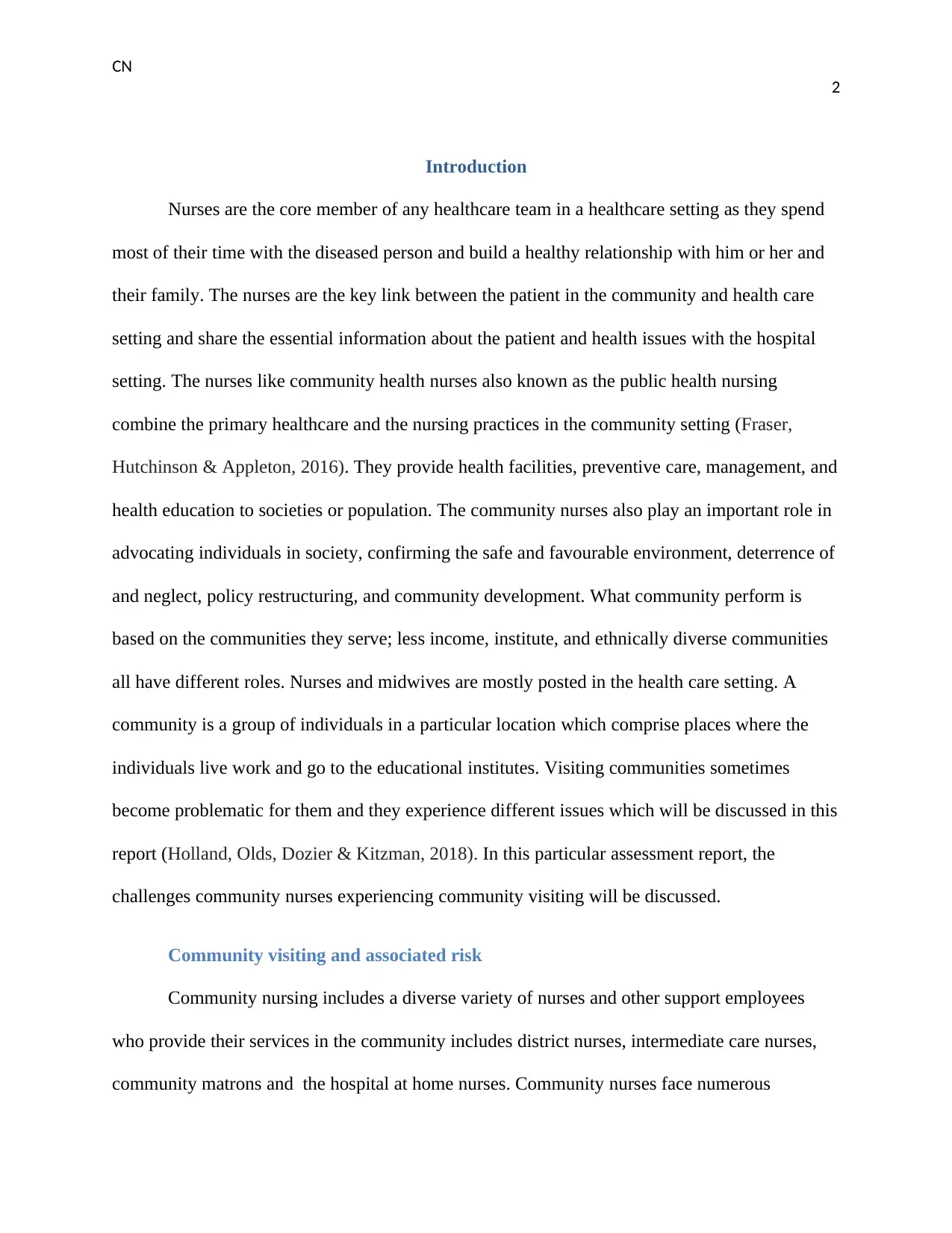
CN
2
Introduction
Nurses are the core member of any healthcare team in a healthcare setting as they spend
most of their time with the diseased person and build a healthy relationship with him or her and
their family. The nurses are the key link between the patient in the community and health care
setting and share the essential information about the patient and health issues with the hospital
setting. The nurses like community health nurses also known as the public health nursing
combine the primary healthcare and the nursing practices in the community setting (Fraser,
Hutchinson & Appleton, 2016). They provide health facilities, preventive care, management, and
health education to societies or population. The community nurses also play an important role in
advocating individuals in society, confirming the safe and favourable environment, deterrence of
and neglect, policy restructuring, and community development. What community perform is
based on the communities they serve; less income, institute, and ethnically diverse communities
all have different roles. Nurses and midwives are mostly posted in the health care setting. A
community is a group of individuals in a particular location which comprise places where the
individuals live work and go to the educational institutes. Visiting communities sometimes
become problematic for them and they experience different issues which will be discussed in this
report (Holland, Olds, Dozier & Kitzman, 2018). In this particular assessment report, the
challenges community nurses experiencing community visiting will be discussed.
Community visiting and associated risk
Community nursing includes a diverse variety of nurses and other support employees
who provide their services in the community includes district nurses, intermediate care nurses,
community matrons and the hospital at home nurses. Community nurses face numerous
2
Introduction
Nurses are the core member of any healthcare team in a healthcare setting as they spend
most of their time with the diseased person and build a healthy relationship with him or her and
their family. The nurses are the key link between the patient in the community and health care
setting and share the essential information about the patient and health issues with the hospital
setting. The nurses like community health nurses also known as the public health nursing
combine the primary healthcare and the nursing practices in the community setting (Fraser,
Hutchinson & Appleton, 2016). They provide health facilities, preventive care, management, and
health education to societies or population. The community nurses also play an important role in
advocating individuals in society, confirming the safe and favourable environment, deterrence of
and neglect, policy restructuring, and community development. What community perform is
based on the communities they serve; less income, institute, and ethnically diverse communities
all have different roles. Nurses and midwives are mostly posted in the health care setting. A
community is a group of individuals in a particular location which comprise places where the
individuals live work and go to the educational institutes. Visiting communities sometimes
become problematic for them and they experience different issues which will be discussed in this
report (Holland, Olds, Dozier & Kitzman, 2018). In this particular assessment report, the
challenges community nurses experiencing community visiting will be discussed.
Community visiting and associated risk
Community nursing includes a diverse variety of nurses and other support employees
who provide their services in the community includes district nurses, intermediate care nurses,
community matrons and the hospital at home nurses. Community nurses face numerous
⊘ This is a preview!⊘
Do you want full access?
Subscribe today to unlock all pages.

Trusted by 1+ million students worldwide
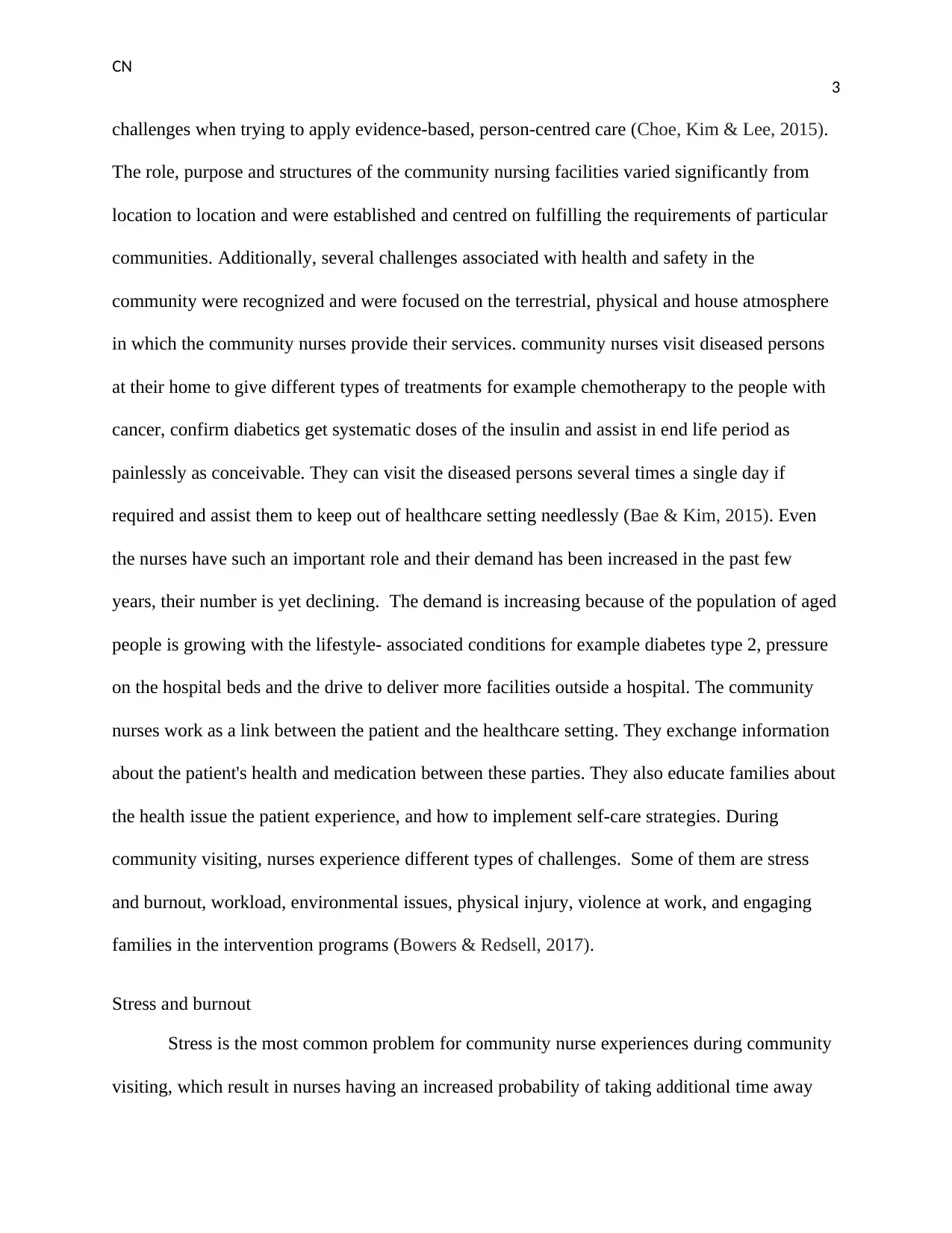
CN
3
challenges when trying to apply evidence-based, person-centred care (Choe, Kim & Lee, 2015).
The role, purpose and structures of the community nursing facilities varied significantly from
location to location and were established and centred on fulfilling the requirements of particular
communities. Additionally, several challenges associated with health and safety in the
community were recognized and were focused on the terrestrial, physical and house atmosphere
in which the community nurses provide their services. community nurses visit diseased persons
at their home to give different types of treatments for example chemotherapy to the people with
cancer, confirm diabetics get systematic doses of the insulin and assist in end life period as
painlessly as conceivable. They can visit the diseased persons several times a single day if
required and assist them to keep out of healthcare setting needlessly (Bae & Kim, 2015). Even
the nurses have such an important role and their demand has been increased in the past few
years, their number is yet declining. The demand is increasing because of the population of aged
people is growing with the lifestyle- associated conditions for example diabetes type 2, pressure
on the hospital beds and the drive to deliver more facilities outside a hospital. The community
nurses work as a link between the patient and the healthcare setting. They exchange information
about the patient's health and medication between these parties. They also educate families about
the health issue the patient experience, and how to implement self-care strategies. During
community visiting, nurses experience different types of challenges. Some of them are stress
and burnout, workload, environmental issues, physical injury, violence at work, and engaging
families in the intervention programs (Bowers & Redsell, 2017).
Stress and burnout
Stress is the most common problem for community nurse experiences during community
visiting, which result in nurses having an increased probability of taking additional time away
3
challenges when trying to apply evidence-based, person-centred care (Choe, Kim & Lee, 2015).
The role, purpose and structures of the community nursing facilities varied significantly from
location to location and were established and centred on fulfilling the requirements of particular
communities. Additionally, several challenges associated with health and safety in the
community were recognized and were focused on the terrestrial, physical and house atmosphere
in which the community nurses provide their services. community nurses visit diseased persons
at their home to give different types of treatments for example chemotherapy to the people with
cancer, confirm diabetics get systematic doses of the insulin and assist in end life period as
painlessly as conceivable. They can visit the diseased persons several times a single day if
required and assist them to keep out of healthcare setting needlessly (Bae & Kim, 2015). Even
the nurses have such an important role and their demand has been increased in the past few
years, their number is yet declining. The demand is increasing because of the population of aged
people is growing with the lifestyle- associated conditions for example diabetes type 2, pressure
on the hospital beds and the drive to deliver more facilities outside a hospital. The community
nurses work as a link between the patient and the healthcare setting. They exchange information
about the patient's health and medication between these parties. They also educate families about
the health issue the patient experience, and how to implement self-care strategies. During
community visiting, nurses experience different types of challenges. Some of them are stress
and burnout, workload, environmental issues, physical injury, violence at work, and engaging
families in the intervention programs (Bowers & Redsell, 2017).
Stress and burnout
Stress is the most common problem for community nurse experiences during community
visiting, which result in nurses having an increased probability of taking additional time away
Paraphrase This Document
Need a fresh take? Get an instant paraphrase of this document with our AI Paraphraser
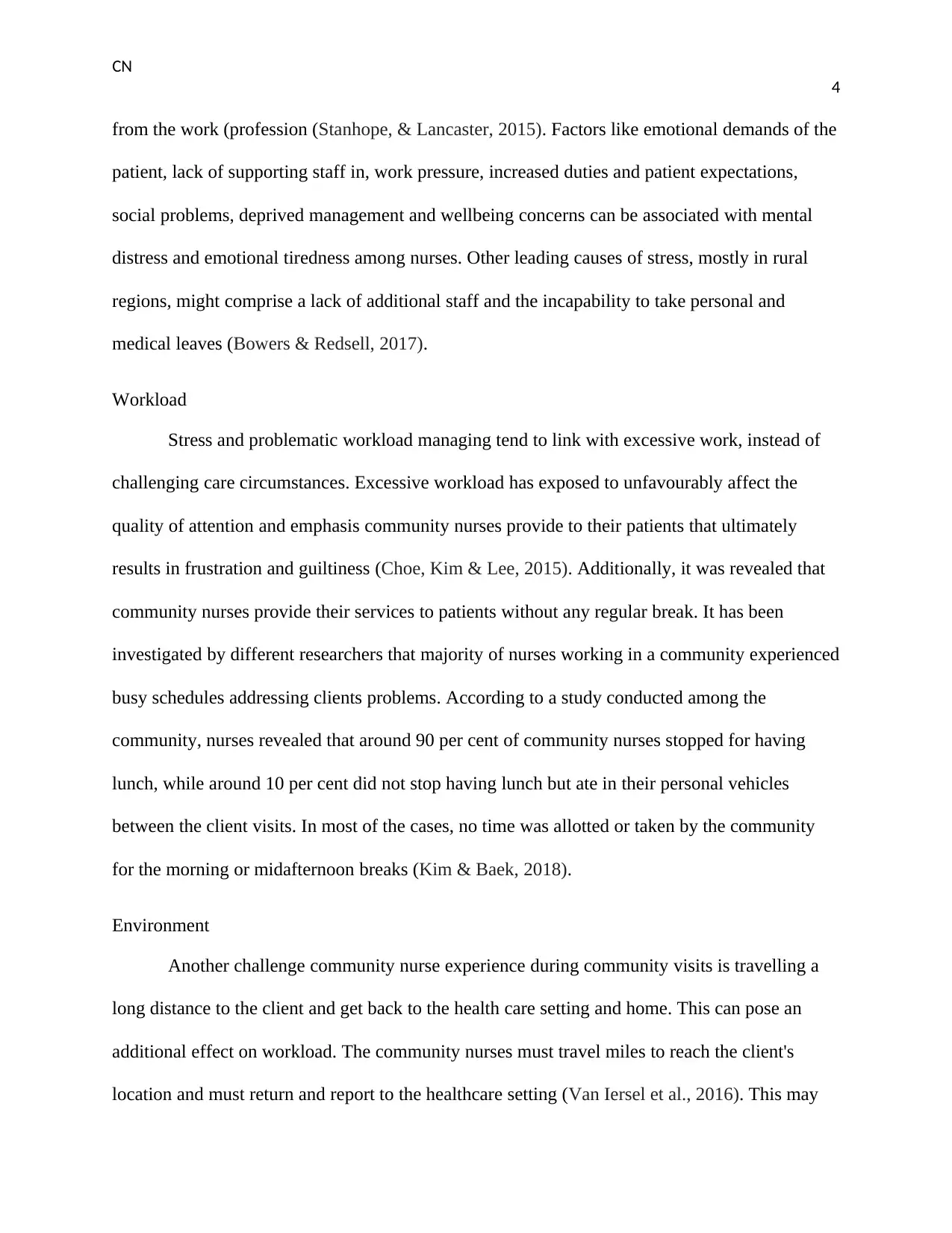
CN
4
from the work (profession (Stanhope, & Lancaster, 2015). Factors like emotional demands of the
patient, lack of supporting staff in, work pressure, increased duties and patient expectations,
social problems, deprived management and wellbeing concerns can be associated with mental
distress and emotional tiredness among nurses. Other leading causes of stress, mostly in rural
regions, might comprise a lack of additional staff and the incapability to take personal and
medical leaves (Bowers & Redsell, 2017).
Workload
Stress and problematic workload managing tend to link with excessive work, instead of
challenging care circumstances. Excessive workload has exposed to unfavourably affect the
quality of attention and emphasis community nurses provide to their patients that ultimately
results in frustration and guiltiness (Choe, Kim & Lee, 2015). Additionally, it was revealed that
community nurses provide their services to patients without any regular break. It has been
investigated by different researchers that majority of nurses working in a community experienced
busy schedules addressing clients problems. According to a study conducted among the
community, nurses revealed that around 90 per cent of community nurses stopped for having
lunch, while around 10 per cent did not stop having lunch but ate in their personal vehicles
between the client visits. In most of the cases, no time was allotted or taken by the community
for the morning or midafternoon breaks (Kim & Baek, 2018).
Environment
Another challenge community nurse experience during community visits is travelling a
long distance to the client and get back to the health care setting and home. This can pose an
additional effect on workload. The community nurses must travel miles to reach the client's
location and must return and report to the healthcare setting (Van Iersel et al., 2016). This may
4
from the work (profession (Stanhope, & Lancaster, 2015). Factors like emotional demands of the
patient, lack of supporting staff in, work pressure, increased duties and patient expectations,
social problems, deprived management and wellbeing concerns can be associated with mental
distress and emotional tiredness among nurses. Other leading causes of stress, mostly in rural
regions, might comprise a lack of additional staff and the incapability to take personal and
medical leaves (Bowers & Redsell, 2017).
Workload
Stress and problematic workload managing tend to link with excessive work, instead of
challenging care circumstances. Excessive workload has exposed to unfavourably affect the
quality of attention and emphasis community nurses provide to their patients that ultimately
results in frustration and guiltiness (Choe, Kim & Lee, 2015). Additionally, it was revealed that
community nurses provide their services to patients without any regular break. It has been
investigated by different researchers that majority of nurses working in a community experienced
busy schedules addressing clients problems. According to a study conducted among the
community, nurses revealed that around 90 per cent of community nurses stopped for having
lunch, while around 10 per cent did not stop having lunch but ate in their personal vehicles
between the client visits. In most of the cases, no time was allotted or taken by the community
for the morning or midafternoon breaks (Kim & Baek, 2018).
Environment
Another challenge community nurse experience during community visits is travelling a
long distance to the client and get back to the health care setting and home. This can pose an
additional effect on workload. The community nurses must travel miles to reach the client's
location and must return and report to the healthcare setting (Van Iersel et al., 2016). This may

CN
5
frequently be time-taking and exhausting for community nurses. To add to their problems, the
conditions of the road in these regions are not continuously well developed or highly maintained.
In the case of geographical and climate of the client location can upsurge the vulnerability of
community nurses. In different cases, the weather associated problems and injuries can results in
high levels of absenteeism for the work (Phelan, McCarthy & Adams, 2018).
Physical injury
Along with with the environmental hazards, some physical hazards are also experienced
by the community nurses, for example, exposure to biological infectious agents, smoke,
chemical, mechanical and that upsurges the risk to wellbeing. The most communal physical harm
among the community nurses linked to musculoskeletal illnesses comprises soft tissue and
nearby structures that happen in the neck area, shoulder, etc (Coffey et al., 2017). there is several
studies have been conducted about physical injury among community nurses and found that 48
per cent of all the community nurses had a physical injury within their nursing workplace that
resulted in being away from work from one to more than five days (Black, 2016). A community
nurse visits diseased persons in their home and has minor control over the physical situation of a
home. The community nurses assist a range of patients, comprising those who are facing issues
in caring for themselves, insufficiency of support system or have no resources access. Navigating
the unkempt patient home is not unfamiliar for the community nurse. The community nurses
must-visit patients where they live. The design or structure of the patient home can also cause
challenges as well. Different patients with movement issues might not have the suitable safety
equipment installed in the home. For instance, the bathroom of patient’s house might not be
capable to physically fit the wheelchair, which can be a risk to safety, as inappropriate transfer
methods might be used and outcome in harm to the nurse and/or the diseased person (Chilton,
5
frequently be time-taking and exhausting for community nurses. To add to their problems, the
conditions of the road in these regions are not continuously well developed or highly maintained.
In the case of geographical and climate of the client location can upsurge the vulnerability of
community nurses. In different cases, the weather associated problems and injuries can results in
high levels of absenteeism for the work (Phelan, McCarthy & Adams, 2018).
Physical injury
Along with with the environmental hazards, some physical hazards are also experienced
by the community nurses, for example, exposure to biological infectious agents, smoke,
chemical, mechanical and that upsurges the risk to wellbeing. The most communal physical harm
among the community nurses linked to musculoskeletal illnesses comprises soft tissue and
nearby structures that happen in the neck area, shoulder, etc (Coffey et al., 2017). there is several
studies have been conducted about physical injury among community nurses and found that 48
per cent of all the community nurses had a physical injury within their nursing workplace that
resulted in being away from work from one to more than five days (Black, 2016). A community
nurse visits diseased persons in their home and has minor control over the physical situation of a
home. The community nurses assist a range of patients, comprising those who are facing issues
in caring for themselves, insufficiency of support system or have no resources access. Navigating
the unkempt patient home is not unfamiliar for the community nurse. The community nurses
must-visit patients where they live. The design or structure of the patient home can also cause
challenges as well. Different patients with movement issues might not have the suitable safety
equipment installed in the home. For instance, the bathroom of patient’s house might not be
capable to physically fit the wheelchair, which can be a risk to safety, as inappropriate transfer
methods might be used and outcome in harm to the nurse and/or the diseased person (Chilton,
⊘ This is a preview!⊘
Do you want full access?
Subscribe today to unlock all pages.

Trusted by 1+ million students worldwide
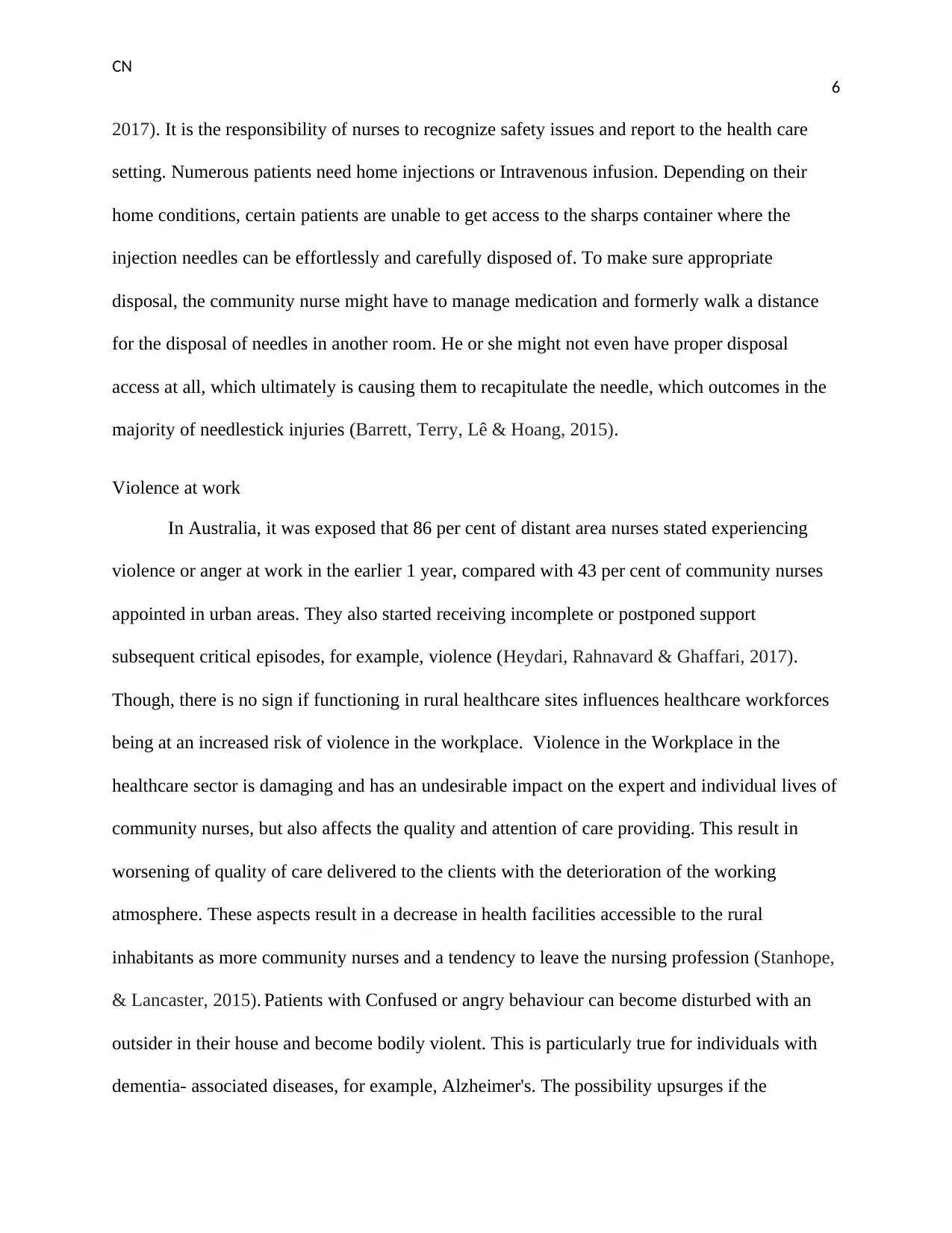
CN
6
2017). It is the responsibility of nurses to recognize safety issues and report to the health care
setting. Numerous patients need home injections or Intravenous infusion. Depending on their
home conditions, certain patients are unable to get access to the sharps container where the
injection needles can be effortlessly and carefully disposed of. To make sure appropriate
disposal, the community nurse might have to manage medication and formerly walk a distance
for the disposal of needles in another room. He or she might not even have proper disposal
access at all, which ultimately is causing them to recapitulate the needle, which outcomes in the
majority of needlestick injuries (Barrett, Terry, Lê & Hoang, 2015).
Violence at work
In Australia, it was exposed that 86 per cent of distant area nurses stated experiencing
violence or anger at work in the earlier 1 year, compared with 43 per cent of community nurses
appointed in urban areas. They also started receiving incomplete or postponed support
subsequent critical episodes, for example, violence (Heydari, Rahnavard & Ghaffari, 2017).
Though, there is no sign if functioning in rural healthcare sites influences healthcare workforces
being at an increased risk of violence in the workplace. Violence in the Workplace in the
healthcare sector is damaging and has an undesirable impact on the expert and individual lives of
community nurses, but also affects the quality and attention of care providing. This result in
worsening of quality of care delivered to the clients with the deterioration of the working
atmosphere. These aspects result in a decrease in health facilities accessible to the rural
inhabitants as more community nurses and a tendency to leave the nursing profession (Stanhope,
& Lancaster, 2015). Patients with Confused or angry behaviour can become disturbed with an
outsider in their house and become bodily violent. This is particularly true for individuals with
dementia- associated diseases, for example, Alzheimer's. The possibility upsurges if the
6
2017). It is the responsibility of nurses to recognize safety issues and report to the health care
setting. Numerous patients need home injections or Intravenous infusion. Depending on their
home conditions, certain patients are unable to get access to the sharps container where the
injection needles can be effortlessly and carefully disposed of. To make sure appropriate
disposal, the community nurse might have to manage medication and formerly walk a distance
for the disposal of needles in another room. He or she might not even have proper disposal
access at all, which ultimately is causing them to recapitulate the needle, which outcomes in the
majority of needlestick injuries (Barrett, Terry, Lê & Hoang, 2015).
Violence at work
In Australia, it was exposed that 86 per cent of distant area nurses stated experiencing
violence or anger at work in the earlier 1 year, compared with 43 per cent of community nurses
appointed in urban areas. They also started receiving incomplete or postponed support
subsequent critical episodes, for example, violence (Heydari, Rahnavard & Ghaffari, 2017).
Though, there is no sign if functioning in rural healthcare sites influences healthcare workforces
being at an increased risk of violence in the workplace. Violence in the Workplace in the
healthcare sector is damaging and has an undesirable impact on the expert and individual lives of
community nurses, but also affects the quality and attention of care providing. This result in
worsening of quality of care delivered to the clients with the deterioration of the working
atmosphere. These aspects result in a decrease in health facilities accessible to the rural
inhabitants as more community nurses and a tendency to leave the nursing profession (Stanhope,
& Lancaster, 2015). Patients with Confused or angry behaviour can become disturbed with an
outsider in their house and become bodily violent. This is particularly true for individuals with
dementia- associated diseases, for example, Alzheimer's. The possibility upsurges if the
Paraphrase This Document
Need a fresh take? Get an instant paraphrase of this document with our AI Paraphraser
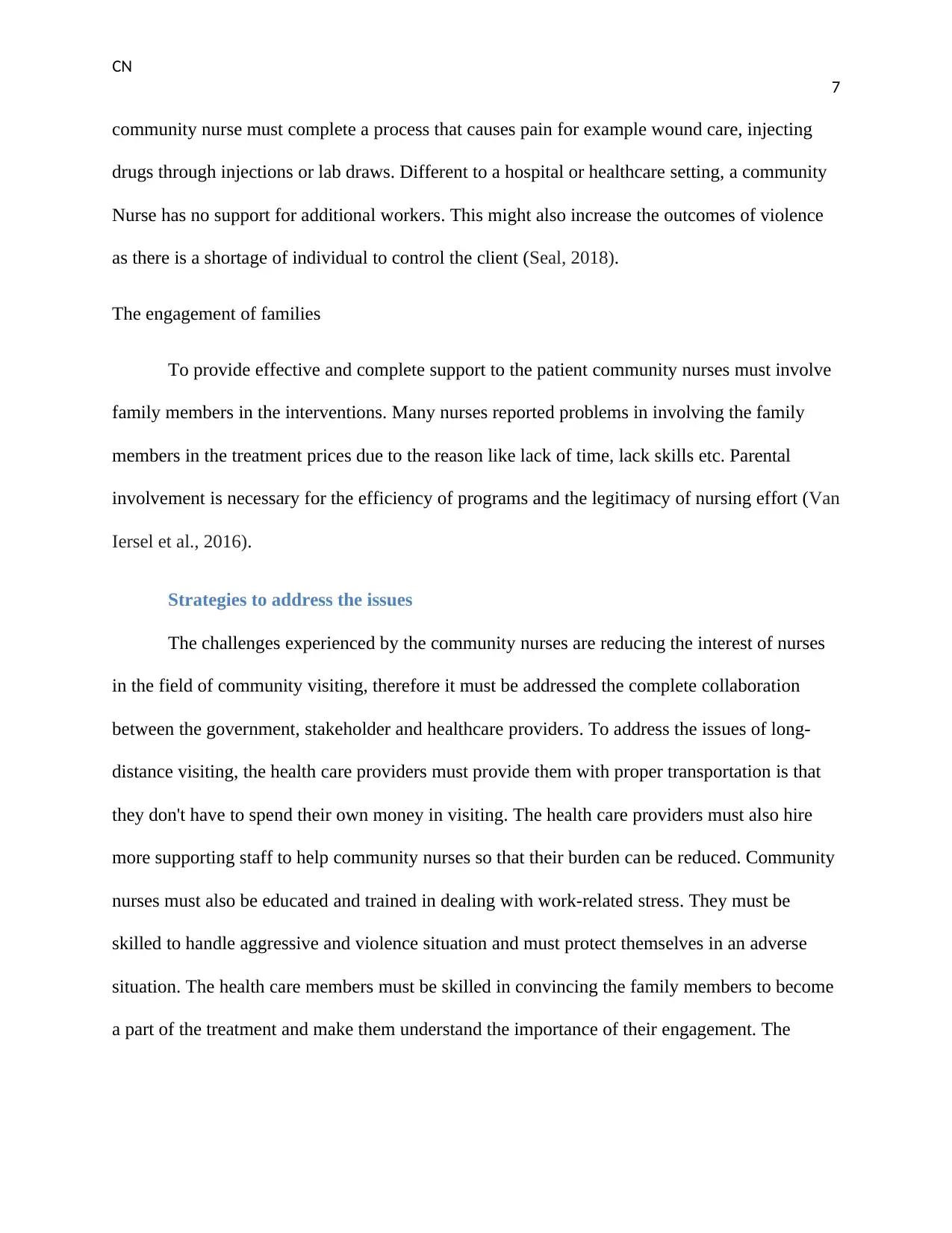
CN
7
community nurse must complete a process that causes pain for example wound care, injecting
drugs through injections or lab draws. Different to a hospital or healthcare setting, a community
Nurse has no support for additional workers. This might also increase the outcomes of violence
as there is a shortage of individual to control the client (Seal, 2018).
The engagement of families
To provide effective and complete support to the patient community nurses must involve
family members in the interventions. Many nurses reported problems in involving the family
members in the treatment prices due to the reason like lack of time, lack skills etc. Parental
involvement is necessary for the efficiency of programs and the legitimacy of nursing effort (Van
Iersel et al., 2016).
Strategies to address the issues
The challenges experienced by the community nurses are reducing the interest of nurses
in the field of community visiting, therefore it must be addressed the complete collaboration
between the government, stakeholder and healthcare providers. To address the issues of long-
distance visiting, the health care providers must provide them with proper transportation is that
they don't have to spend their own money in visiting. The health care providers must also hire
more supporting staff to help community nurses so that their burden can be reduced. Community
nurses must also be educated and trained in dealing with work-related stress. They must be
skilled to handle aggressive and violence situation and must protect themselves in an adverse
situation. The health care members must be skilled in convincing the family members to become
a part of the treatment and make them understand the importance of their engagement. The
7
community nurse must complete a process that causes pain for example wound care, injecting
drugs through injections or lab draws. Different to a hospital or healthcare setting, a community
Nurse has no support for additional workers. This might also increase the outcomes of violence
as there is a shortage of individual to control the client (Seal, 2018).
The engagement of families
To provide effective and complete support to the patient community nurses must involve
family members in the interventions. Many nurses reported problems in involving the family
members in the treatment prices due to the reason like lack of time, lack skills etc. Parental
involvement is necessary for the efficiency of programs and the legitimacy of nursing effort (Van
Iersel et al., 2016).
Strategies to address the issues
The challenges experienced by the community nurses are reducing the interest of nurses
in the field of community visiting, therefore it must be addressed the complete collaboration
between the government, stakeholder and healthcare providers. To address the issues of long-
distance visiting, the health care providers must provide them with proper transportation is that
they don't have to spend their own money in visiting. The health care providers must also hire
more supporting staff to help community nurses so that their burden can be reduced. Community
nurses must also be educated and trained in dealing with work-related stress. They must be
skilled to handle aggressive and violence situation and must protect themselves in an adverse
situation. The health care members must be skilled in convincing the family members to become
a part of the treatment and make them understand the importance of their engagement. The
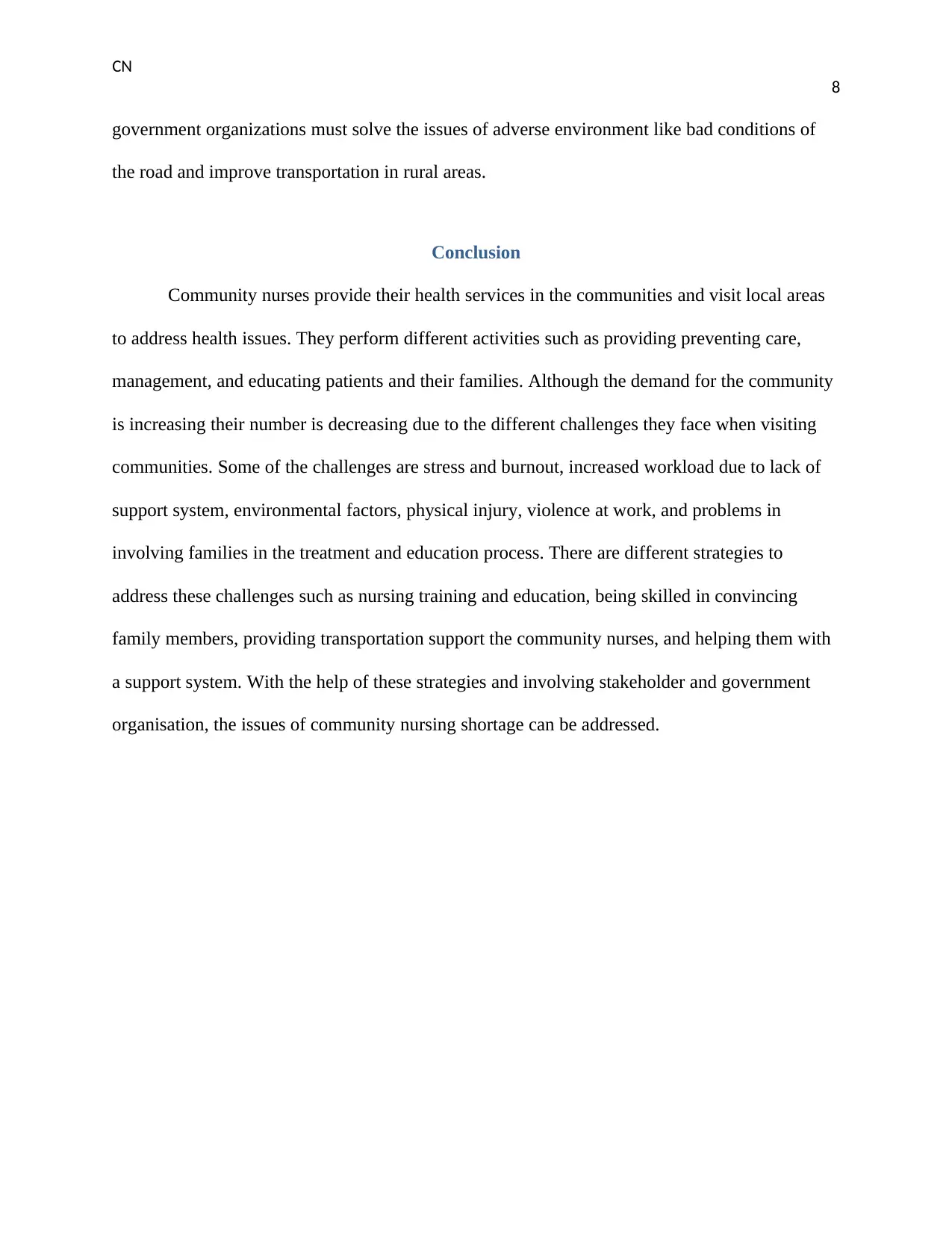
CN
8
government organizations must solve the issues of adverse environment like bad conditions of
the road and improve transportation in rural areas.
Conclusion
Community nurses provide their health services in the communities and visit local areas
to address health issues. They perform different activities such as providing preventing care,
management, and educating patients and their families. Although the demand for the community
is increasing their number is decreasing due to the different challenges they face when visiting
communities. Some of the challenges are stress and burnout, increased workload due to lack of
support system, environmental factors, physical injury, violence at work, and problems in
involving families in the treatment and education process. There are different strategies to
address these challenges such as nursing training and education, being skilled in convincing
family members, providing transportation support the community nurses, and helping them with
a support system. With the help of these strategies and involving stakeholder and government
organisation, the issues of community nursing shortage can be addressed.
8
government organizations must solve the issues of adverse environment like bad conditions of
the road and improve transportation in rural areas.
Conclusion
Community nurses provide their health services in the communities and visit local areas
to address health issues. They perform different activities such as providing preventing care,
management, and educating patients and their families. Although the demand for the community
is increasing their number is decreasing due to the different challenges they face when visiting
communities. Some of the challenges are stress and burnout, increased workload due to lack of
support system, environmental factors, physical injury, violence at work, and problems in
involving families in the treatment and education process. There are different strategies to
address these challenges such as nursing training and education, being skilled in convincing
family members, providing transportation support the community nurses, and helping them with
a support system. With the help of these strategies and involving stakeholder and government
organisation, the issues of community nursing shortage can be addressed.
⊘ This is a preview!⊘
Do you want full access?
Subscribe today to unlock all pages.

Trusted by 1+ million students worldwide

CN
9
References
Bae, H. J., & Kim, J. (2015). Estimating need for home visiting nurse from public health
centers. Perspectives in Nursing Science, 12(1), 23-32.
Barrett, A., Terry, D. R., Lê, Q., & Hoang, H. (2015). Rural Community Nurses: Insights into
Health Workforce and Health Service Needs. International Journal of Health, Wellness
& Society, 5(3).
Black, B. (2016). Professional nursing-E-book: Concepts & challenges. Elsevier Health
Sciences.
Bowers, B., & Redsell, S. A. (2017). A qualitative study of community nurses’ decision‐making
around the anticipatory prescribing of end‐of‐life medications. Journal of advanced
nursing, 73(10), 2385-2394.
Chilton, S. (2017). Nursing in a community environment. In A Textbook of Community
Nursing (pp. 1-24). Routledge.
Choe, K., Kim, K., & Lee, K. S. (2015). Ethical concerns of visiting nurses caring for older
people in the community. Nursing ethics, 22(6), 700-710.
Coffey, A., Mulcahy, H., Savage, E., Fitzgerald, S., Bradley, C., Benefield, L., & Leahy‐Warren,
P. (2017). Transitional care interventions: Relevance for nursing in the
community. Public Health Nursing, 34(5), 454-460.
9
References
Bae, H. J., & Kim, J. (2015). Estimating need for home visiting nurse from public health
centers. Perspectives in Nursing Science, 12(1), 23-32.
Barrett, A., Terry, D. R., Lê, Q., & Hoang, H. (2015). Rural Community Nurses: Insights into
Health Workforce and Health Service Needs. International Journal of Health, Wellness
& Society, 5(3).
Black, B. (2016). Professional nursing-E-book: Concepts & challenges. Elsevier Health
Sciences.
Bowers, B., & Redsell, S. A. (2017). A qualitative study of community nurses’ decision‐making
around the anticipatory prescribing of end‐of‐life medications. Journal of advanced
nursing, 73(10), 2385-2394.
Chilton, S. (2017). Nursing in a community environment. In A Textbook of Community
Nursing (pp. 1-24). Routledge.
Choe, K., Kim, K., & Lee, K. S. (2015). Ethical concerns of visiting nurses caring for older
people in the community. Nursing ethics, 22(6), 700-710.
Coffey, A., Mulcahy, H., Savage, E., Fitzgerald, S., Bradley, C., Benefield, L., & Leahy‐Warren,
P. (2017). Transitional care interventions: Relevance for nursing in the
community. Public Health Nursing, 34(5), 454-460.
Paraphrase This Document
Need a fresh take? Get an instant paraphrase of this document with our AI Paraphraser

CN
10
Fraser, J. A., Hutchinson, M., & Appleton, J. (2016). Nurses’ experiences of home visiting new
parents in rural and regional communities in Australia: a descriptive qualitative
study. Journal of children's services, 11(3), 204-216.
Heydari, H., Rahnavard, Z., & Ghaffari, F. (2017). Exploring the position of community-based
nursing in Iran: a Qualitative Study. International journal of community based nursing
and midwifery, 5(4), 386.
Holland, M. L., Olds, D. L., Dozier, A. M., & Kitzman, H. J. (2018). Visit attendance patterns in
nurse-family partnership community sites. Prevention Science, 19(4), 516-527.
Kim, Y. S., & Baek, H. C. (2018). Factors influencing Health Promoting Behaviors of Visiting
Nurses in Seoul. Journal of Korean Academic Society of Home Health Care
Nursing, 25(2), 209-218.
Phelan, A., McCarthy, S., & Adams, E. (2018). Examining missed care in community nursing: A
cross section survey design. Journal of advanced nursing, 74(3), 626-636.
Seal, J. (2018). Specialist community public health nursing: Understanding and exploring
assessment for learning. Journal of Health Visiting, 6(5), 248-253.
Stanhope, M., & Lancaster, J. (2015). Public health nursing-e-book: Population-centered health
care in the community. Elsevier Health Sciences.
Van Iersel, M., Latour, C. H., De Vos, R., Kirschner, P. A., & op Reimer, W. J. S. (2016).
Nursing students’ perceptions of community care and other areas of nursing practice–A
review of the literature. International journal of nursing studies, 61, 1-19.
10
Fraser, J. A., Hutchinson, M., & Appleton, J. (2016). Nurses’ experiences of home visiting new
parents in rural and regional communities in Australia: a descriptive qualitative
study. Journal of children's services, 11(3), 204-216.
Heydari, H., Rahnavard, Z., & Ghaffari, F. (2017). Exploring the position of community-based
nursing in Iran: a Qualitative Study. International journal of community based nursing
and midwifery, 5(4), 386.
Holland, M. L., Olds, D. L., Dozier, A. M., & Kitzman, H. J. (2018). Visit attendance patterns in
nurse-family partnership community sites. Prevention Science, 19(4), 516-527.
Kim, Y. S., & Baek, H. C. (2018). Factors influencing Health Promoting Behaviors of Visiting
Nurses in Seoul. Journal of Korean Academic Society of Home Health Care
Nursing, 25(2), 209-218.
Phelan, A., McCarthy, S., & Adams, E. (2018). Examining missed care in community nursing: A
cross section survey design. Journal of advanced nursing, 74(3), 626-636.
Seal, J. (2018). Specialist community public health nursing: Understanding and exploring
assessment for learning. Journal of Health Visiting, 6(5), 248-253.
Stanhope, M., & Lancaster, J. (2015). Public health nursing-e-book: Population-centered health
care in the community. Elsevier Health Sciences.
Van Iersel, M., Latour, C. H., De Vos, R., Kirschner, P. A., & op Reimer, W. J. S. (2016).
Nursing students’ perceptions of community care and other areas of nursing practice–A
review of the literature. International journal of nursing studies, 61, 1-19.
1 out of 11
Related Documents
Your All-in-One AI-Powered Toolkit for Academic Success.
+13062052269
info@desklib.com
Available 24*7 on WhatsApp / Email
![[object Object]](/_next/static/media/star-bottom.7253800d.svg)
Unlock your academic potential
Copyright © 2020–2025 A2Z Services. All Rights Reserved. Developed and managed by ZUCOL.




